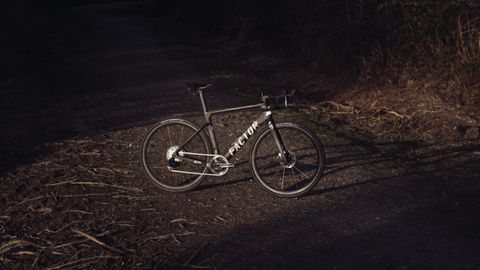Cyclingnews Verdict
Incredible in its comfort zone, but too specialist for its own good
Pros
- +
Very, very fast
- +
Striking looks
Cons
- -
Uncomfortable
- -
Not as versatile as many modern road bikes
- -
No mudguard mounts
You can trust Cyclingnews
It seems like we’ve come full circle. I remember when the 3T Exploro launched and everyone collectively lost their minds for a short time at the concept of an aero gravel bike. There have been gravel bikes since that certainly pay attention to aerodynamics, but to my mind, there hasn’t been a bike in the gravel segment that focuses so heavily on aerodynamics as the Factor Ostro Gravel. It is unashamedly a gravel race bike, so much so that it’s UCI-legal for the road.
Can something so specialist sit amongst the best gravel bikes, or even the best gravel race bikes? Well, I’m not going to tell you in this paragraph, but I think as a bike it poses some really interesting questions for the future of the segment, particularly if gravel racing and mass participation events continue to grow and reach the level of peak-fondo from six or so years ago.
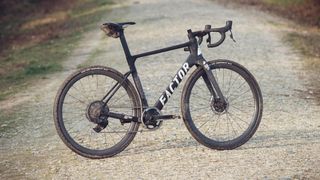
Design and aesthetics
I make no bones about the fact that I am not overly enamoured with the aesthetics of the best aero road bikes. However, being a man of contradiction, I actually really like the way the Factor Ostro Gravel looks. I think this is partially because it’s one of the first of its kind, so there is something of a novelty factor (pun not intended), but I think it also has to do with the harsh juxtaposition of such a man-made object being used off-road, in a natural setting that’s just kind of cool. It’s so clearly inorganic, jagged, and focused that it commands a little more attention. It’s a bit like seeing a power station nestled somewhere beautiful; you can’t help but look at it.
Let’s talk design though, rather than me telling you what you should like the look of. It’s clear from a glance that this is a bike designed to cheat the wind. No wattage savings are claimed over the competition, and there are no predecessors to compare against either. That being said, the deep headtube, kammtail tube profiles, high bottom bracket, and dropped stays are all features common to the best aero road bikes now. The fully integrated setup, and the choice to only allow electronic groupsets, are a further nod to the high-performance aims of the Ostro Gravel.
Considering it's a chunky frame it is remarkably light. A 900g claimed weight for the frame is very skinny indeed. In all honesty that’s light by road bike standards still. The full weight, with a bottle cage and pedals and a good glug of sealant in each of the tyres, was 7.9kg. Perhaps not superlight by road standards, but for a gravel bike it’s pretty phenomenal, although it's still overshadowed by the S-Works Crux, which tips the scales at close to 7.5kg.
The Black Inc. cockpit wouldn’t look out of place on an aero road bike either, and if you’re looking for a new cockpit I’d actually recommend it; it’s very pleasant. You can swap to a traditional bar and stem combo though if you so wish, thanks to the round steerer tube. This also means that, for the purposes of fitting myself to the test bike, I could plop some standard round spacers above the stem rather than having a higher stack than I’d like or slicing it off.




It can be run with 2x systems - it seems to have a removable plate where a derailleur hanger should be, but it’s only available as a complete bike with SRAM Force XPLR or Red XPLR. Naturally, I was on the fancypants Red version, which does make sense for a bike like this. The range is ample and a 1x is more aero.
Geometry charts can be quite revealing too. In comparison to my Fairlight Secan, the Factor is 5mm longer in terms of reach, has a 0.3-degree steeper head angle, and has a 5mm shorter wheelbase. It’s also got a 3mm smaller BB drop (the bottom bracket is higher) and is taller at the front with an 8mm higher stack. That 0.3-degree difference in head angle may not seem like much, but it’s what allows the bike to feel longer (longer reach/effective top tube) while also ending up with a shorter wheelbase. Small increments in BB drop also have a big impact, and while they look similar on paper the two are chalk and cheese.
A final point, more as a question than anything else: If you can add four bosses for a bottle on the top tube and under the down tube, surely you could add a couple more for some mudguards? Especially given this is also marketed as an all-road bike, being able to stay dry and clean would really be of benefit. No, they’re not aero, but they’ll certainly help stop manure spraying all over the nozzle of your downtube bottle for one thing.





Performance
When asked to perform within a relatively specific range of parameters this bike is absolutely sensational. On smooth, well-graded gravel it is like being shot out of a cannon. It is taut and lithe and responsive, but most of all it just tempts you to sit in an aero position and treat your ride like some sort of gravel time trial. The stiffness is up there with any high-end road bike for power transfer. On the right surface, it is very reminiscent of riding an aero road bike, except the geometry is different.
The handling, again provided you’re on the right terrain, is brilliant. You can pick your way between rocks with ease when flying down tight corners and change your line quite happily without a second thought. Part of that is the geometry, but a lot of it comes down to the tyres and wheels. The wheels are very stiff and stand up to hard cornering well without feeling mushy, but the tyres are a real stroke of genius in terms of speccing, especially given tyres are usually the first thing to get downgraded to hit a price point.
This isn’t a tyre review, but suffice it to say there was very little left wanting from the Goodyear Connectors. Extremely fast on gravel and on-road sections too, with side knobs that handle off camber with ease and, to my surprise, rather capable in mud too. Not like a cyclocross tyre would be, but for a general-purpose gravel tyre they were tip-top and were an extremely complementary choice.
It's worth noting at this point that Factor sponsored athletes (Dylan Johnson et al) use 45mm tyres almost exclusively on this bike, which is slightly at odds with what it comes as stock with. Yes, this would undoubtedly improve the comfort factor of what's an incredibly stiff bike, but given that the bike is optimised for 32mm tyres from an aerodynamic perspective it seems to me like a reverse engineering fix. Wider tyres are less aero, and while there are certainly claims about wider tyres having lower rolling resistance, the jury is still out on that one. I suspect the sweet spot would be around 42mm, but that's going to vary depending on the terrain you regularly ride over.
The groupset makes perfect sense too, considering the aspirations of the bike. The gear range is such that no climbs are ever going to be too much, either on or off-road, especially considering you’re not realistically going to be strapping any real cargo to the frame. I did suffer from a slightly sticky rear brake piston and a creaky bottom bracket, but you never know how media test bikes have been treated before they arrive.
Finally, before we dive into some of the drawbacks, I’d like to champion the cockpit. The shape is great, the flare is subtle but there enough to make the drops feel like a more stable option. The drop is round and deep too, and the bars are narrow enough to feel at home on an aero machine. What’s more, the bar tape is very grippy, and the tops have been wrapped too.
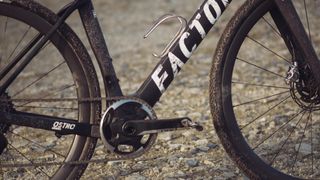
Here’s where things start to fall down slightly: If you take it on anything remotely rough it’s unpleasant. The same stiffness from the frame and the components, along with the geometry that makes it such a fast and responsive bike on the smooth stuff makes it jarring and hard to handle off-road. The rear end has so little compliance that on rocky ground it's not only uncomfortable for your rear end but also it makes putting the power down harder, which effectively makes you slower. The best tactic is a little like riding bikes over cobbles; go as hard and fast as possible and hope you fly over.
Rare is it that I have to cut a ride short for discomfort reasons, but it did happen with the Factor Ostro Gravel. It reminded me a lot in some ways of the Ribble Ultra SL, in that its hyper-focus on a single aim has actually gone so far as to be detrimental for the generalist.
To preempt what I’m sure some of you are itching to say, yes, you can spec wider tyres to improve compliance. My retort to this is twofold. Firstly, this is the spec I am testing so in that respect I am a trifle hamstrung. Secondly, and more importantly, the bike is marketed as optimised for a 32mm tyre. If you’re racing and you have to use a bigger tyre just to bear riding the thing then you're both adding weight and rolling resistance in order to effect compliance that would, from a performance standpoint, be better offered by a more flexible rear end. It is where I think the Specialized Diverge is onto something with its utilisation of suspension, though I'm not totally sold on the delivery. Smooth is, to some degree, fast I’m afraid to say and beyond the realms of beautiful fire roads, the Factor Ostro Gravel is actually hampered by itself. Given the proprietary seatpost, you cant use something like a Redshift seatpost to add comfort.
On the road, it’s an extremely pleasant experience. It feels very much like an endurance road bike, but with less-than-ideal tyres. In all honesty, I regularly felt relieved to get back on the tarmac, which isn’t exactly a glowing indictment. The handling is still nimble enough to feel alive on roads, and I think Factor is justified in marketing it as a viable all-road bike as a secondary purpose.
Now for a difficult question. In my opinion, this bike is only really viable as a race bike on well-graded gravel. The inaugural gravel world championships were won on a Canyon Ultimate road bike running a 32/25mm front/rear tyre setup, and a similar setup also on a Canyon Ultimate for second place too. With this in mind, do you really need a gravel bike for smooth gravel anymore? For the most part, you’re gaining the geometry of an all-road bike like the Trek Domane or dare I say the Specialized Roubaix, and upgrading the aero package drastically but reducing the versatility by an equal amount. I’ve tested the Roubaix and I think I’d rather slap some 32mm tyres on that for my usual gravel riding.
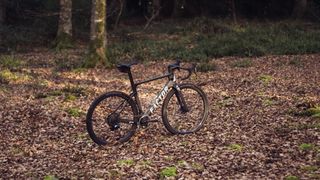
Value
Oh boy, ok. It’s $9,799 / €9,710 / £8,430. That’s not quite Trek Domane SLR 9 money, but it is a far more specialist machine. Given its specialism for a discipline that is still relatively youthful, I feel it's useful to frame it as if it were a different discipline entirely. For example, some keen amateur time triallists won't think twice £8.5k is an absurd amount of money for a race bike. Likewise, if you’re into hill climbs you may not think anything of dropping £8.5k on a bike build that ends up weighing the same as a sneeze. I consider buying a Factor Ostro Gravel equivalent to these examples.
If you truly are racing on gravel, smooth gravel, it’s a brilliant bit of kit and you will be faster, but it’s absolutely a race bike and only a race bike, and you have to be prepared to potentially have quite an uncomfortable time.
Given its specialism, I cannot say it represents any form of value. I’d struggle to suggest it even for racers because comfort is genuinely a factor in longer events. I had to cut a ride short due to discomfort, so the thought of doing something like Unbound aboard this makes me wince, and sadly that’s effectively what it’s designed for.
Anything tamer and you could equally just use a road bike and have a better road bike on the road because of it. For the same price you could hook yourself up with a Canyon Ultimate with Ultegra Di2 and a dual-sided power meter, and have some change for a set of the best gravel tyres and you’d have a setup more than capable of winning Gravel Worlds (if you’ve got the engine) and any road race you could think of too.
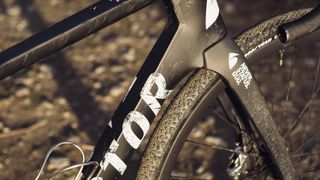
Verdict
When I write bike reviews I often get a very reachy metaphor lodged in my consciousness. In this case, it’s kitchen knives. To me, a gravel bike should be some variation of a chef's knife. It can do most things in the kitchen pretty well. The Factor Ostro Gravel is a fish filleting knife; if you’re on the fish section then it’s absolutely going to be of use to you and will make your life of filleting fish better and faster. If you only rarely have a call to take the bones out of a whole turbot though, it’s mostly going to be an annoyance, especially if you have to chop carrots, peel a courgette, or shred the cabbage.
What I’m trying to say is it’s very good at one thing, and if you do that one thing then it’s a very good option, but if you need to race gravel and do more general riding then I think you should buy something else. To compound this slightly there are road bikes out there now that are perhaps equally good gravel race bikes now for less money.
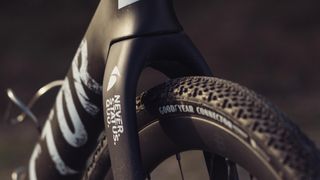
| Attributes | Notes | Rating |
|---|---|---|
| Design and aesthetics | It looks cool, and thought has gone into it. Sensible BB and round steerer win points | 9/10 |
| Build | SRAM Red combined with the Black Inc finishing kit is a winning recipe. Excellent tyres are the cherry on top. | 9/10 |
| Performance | it's a superbike within its comfort zone but unpleasant to ride out of it | 7/10 |
| Weight | It's class leading for gravel bikes, and really can't be faulted | 10/10 |
| Value | It's not enough to be akin to a road bike when road bikes themselves are winning gravel races | 2/10 |
| Overall rating | Row 5 - Cell 1 | 74% |
Specifications: Factor Ostro Gravel
- Price: $9,799/€9,710/£8,430
- Frame: Factor Ostro Gravel
- Size: 56cm
- Weight: 7.9kg (with pedals, sealant and bottle cage)
- Groupset: SRAM Red XPLR with power meter
- Wheels: Black Inc Thirty Four
- Brakes: SRAM Red
- Bar/stem: Black Inc Integrated Aero Barstem
- Seatpost: Factor Ostro Gravel
- Saddle: Selle Italia SLR Boost Gravel

Will joined the Cyclingnews team as a reviews writer in 2022, having previously written for Cyclist, BikeRadar and Advntr. He’s tried his hand at most cycling disciplines, from the standard mix of road, gravel, and mountain bike, to the more unusual like bike polo and tracklocross. He’s made his own bike frames, covered tech news from the biggest races on the planet, and published countless premium galleries thanks to his excellent photographic eye. Also, given he doesn’t ever ride indoors he’s become a real expert on foul-weather riding gear. His collection of bikes is a real smorgasbord, with everything from vintage-style steel tourers through to superlight flat bar hill climb machines.
